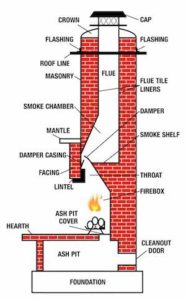Know about Chimney Relining and Types of Liners

Lining is one of the essential components of chimney and it proves to be a costly affair to replace it. Whenever you are facing the issue to pay the high cost of new flue, it helps to know why a liner should be replaced and what types of chimney lining are available. Read on to know more about chimney relining:
What is Chimney Relining?
Most types of chimney flue or liner begin to deteriorate and make your fireplace hazardous. The use of liners are important as they channel heat and gases up through the top of the chimney and block the heat and prevent fire to any combustible materials. Any type of crack or crumbling in liner makes it important to hire chimney contractor to get chimney relined. The chimney professionals advise on relining and make you aware on the damages by using a special camera for chimney inspection. Relining involves installing a new flue liner.
Types of Chimney Liners
In old houses, we hardly find any lining. But for many decades, liners seem to be a requirement in chimneys to channel the heat and gases up through the chimney in a better way and prevent fires. If your chimney doesn’t have a liner then get one before using fireplace.
Metal Flue Liners
Stainless steel flue liners are considered as the best liners by fire-protection experts as they come with a lifetime guarantee. Some of the other metal liners are also available but none of them are as highly recommended as stainless steel. These flue liners are available in flexible and rigid forms. Although, the cost and installation charges of the chimney company are high for stainless steel liners but many people say that it always proves to be a good investment.
Clay Tile Liners
These liners are the cheapest and traditionally favorite liners. A proper installation of this liner can lasts for more than 50 years also but make sure not to miss the regular chimney cleaning and maintenance. Flue tiles can withstand the heat and deposits of corrosive byproducts while burning any fuel type. With time, clay liner tiles tend to deteriorate. This might lead to carbon monoxide leakage and any types of cracks in liners increases the chances of fire as heat gets transferred to combustible materials surrounding the chimney.
Cast-in-Place Liners
Cast-in-place liners are result of poured-cement processes and creates new flue. These flues can withstand all the ill effects of condensation, heat and acids. Cast-in place liners have best insulation properties and decrease the accumulation of creosote and make the fireplace clean. Some of the chimney contractor believe that cement flues last for minimum of five decades and help to stabilize unsound clay flues as they are poured inside on the chimney walls or on the flue.
Whenever you need chimney relining, always remember that liner is where flames, heat, sparks, smoke and carbon monoxide are channeled out of the doors and any compromise on liner could make these hazardous elements enter into your home. Contact your chimney contractor to get the best chimney liner and schedule for annual chimney inspection.
This post first appeared on https://www.firstclasschimneyservices.com


 Parts of the Chimney
Parts of the Chimney